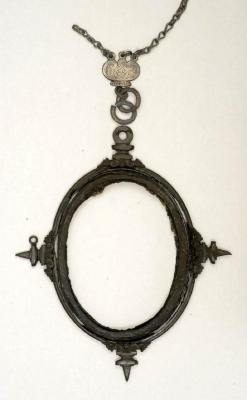Frame Physical Object
Accession Number
1986.008.1499aCategory
Alternate object names
Mirror FrameCreation Date
circa 1620Materials
Description
This oval frame was likely designed for a convex mirror. Convex mirrors, which broadened the viewing perspective, were at the outside edge of early-modern glassmaking technology and were expensive and prized items. The earliest examples of mirrors, from Greco-Roman to Medieval times, were simply made of highly polished metal, and they were small and not terribly reflective. In the sixteenth century, Venetian glassmakers perfected the backing of glass with an amalgam of tin and mercury, and their technique spread rapidly to other countries. Because large mirrors were expensive to create, smaller ones like this were more commonly seen. The frame could also be the remains of a reliquary. Reliquaries are shrine-like containers designed to hold sacred objects ranging from bones or hair of religious figures or articles they had worn or used, to objects associated with miracles, among others. See also 1986.008.1499b--k. Photographed with 1986.008.1499b, e, f.Exhibition Label
Case Caption (2023):A COLONIST— DOÑA MARÍA DE AYALA
Doña María de Ayala had traveled from Spain to Potosí with her husband, Martin Salgado de Rivera, in 1615. High in the Andes, Potosí has cool, wet summers, icy winters, and sits on a barren plain. Everything the couple needed had to be carried up the mountains by llamas. María’s day would have been spent working with her servants to stretch household supplies, haggling with local traders for food and fuel, and mending linens and clothes that could not be readily replaced. Occasionally, floods and earthquakes would add to María’s troubles.
But her husband’s appointments had made them wealthy. When they sailed for Spain, they were accompanied by María’s maid, Catalina, and two very young, possibly Indigenous, servant girls. They all drowned aboard the Nuestra Señora de Atocha.
Object Caption (2023):
Mirror Frame
Silver and gilt (c.1600)
Gift of Jamestown Inc.
1986.008.1499a-k
Previous Exhibit Case Caption: Removed 2022. Mirror Frame with Hanging Chain Early mirrors were made of polished metal and were not very reflective. In the 1500x, Venetian glassmakers learned to cover the back if glass with an amalgam of tin and mercury to improve the reflectiveness. Large mirrors were expensive to make, so smaller ones were more common. This oval mirror frame likely held a convex mirror. It would have allowed a larger viewing perspective for its size.
